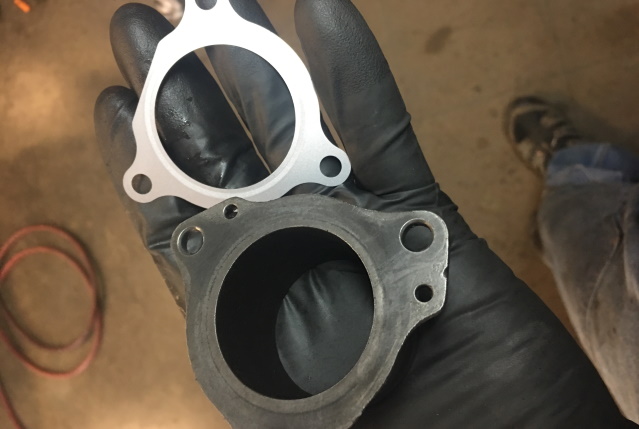
Dirt bikes and ATVs use a variety of gaskets that act as a barrier to outside contaminants and as a lock to keep operating fluids inside a sealed compartment.
Gasket use ranges from the crankcase to the exhaust system and many parts in between. Manufacturers use a wide range of material to make gaskets including rubber, steel and paper. Generally, you cannot reuse a gasket and most often when pulling apart sections using a gasket, the gasket has baked on and comes off in pieces often leaving behind bits stuck to the separated housing.
Prior to applying a fresh gasket, you need a clean canvas, so to speak, so don't expect the new gasket to perform well if crumbs from the old one remain. If you have ever left food in a frying pan too long you know the effort, and overall pain, it takes to completely remove the burned morsels from the surface.
When performing a top end or total engine rebuild on a dirt bike or ATV you need to replace more than a dozen gaskets, just an idea of the number of gaskets that help hold things together. O-ring type gaskets as well as some made of rubber and tin covered in paper come off quite easily and can even be reused several times. Manufacturers of these thicker gaskets make it clear whether you can reuse them. However, if these gaskets do not release cleanly then you need to replace them.
Overall, use most gaskets made of steel, synthetic fiber blend and rubber once. Since these gaskets often bake on to the surface anyway, becoming useless once you pull the accompanying housing apart, you won't need to second guess.

How To Remove Old Gasket
Thankfully, you don't need to let a baked on gasket soak in a sink full of soapy water nor do you need to scrape and scrape with little gains to show. Don't expect an easy-off routine but a number of methods exist that allow you to completely rid a casing of any gasket residue to ensure the fresh gasket works as planned.
Scraper and Razor
Most gaskets lay flush meaning the contact surface is flat. Using a scraper like a paint spatula to remove thicker chunks then a razor blade to remove finer pieces works best. Don't worry about fine scratches to the finish but do take some caution while using both tools, if not for you. Watch those fingers!
These products work best, not just because we sell them, but because they are designed for the purpose of removing gaskets:
Do avoid gauging or marring the surface to prevent the need for resurfacing. Regardless, check crank case half cylinder surfaces and head surfaces prior to putting back together with a straight-edge and feeler gauge set. If untrue, you need to have them resurface probably at a machine shop.
This BikeMaster Scraper Set works well on delicate surfaces as noted above.
Scotch Brite Pads
Scotch Brite pads come in several grits for working on delicate surfaces.
Contact Cleaner
Using contact cleaner, acetone or even brake cleaner helps loosen stubborn baked on pieces of gasket. Tear away thicker portions of old gasket first which, when ripped off, allows the cleaner to permeate the hardened stuff stuck to the housing. Let the cleaner penetrate for a minute or two then commence scraping. A wire brush works well in this instance.
Permatex Gasket Remover
New on the scene and a rapidly popular product comes from Permatex. You'll love the foaming action of the gasket remover and it quickly dissolves remaining gasket stuck to the surface of the casing. Even if unnecessary, we like adding Permatex gasket remover to fully clean and prepare the surface for the new gasket. Don't bother using Permatex gasket remover on silicone gaskets because it's not strong enough.
Gasket Sealant
Some gaskets require the use of extra sealant though most install dry. Extra sealant adds to the baking on effect and the contact cleaner and Permatex dissolves this gunk rather quickly.
Consult the owner's manual of the make and model dirt bike or ATV you have to understand where to apply sealant. Some models require sealant for a specific gasket that another model recommends installing dry. As a general rule most crank cases, with metal to metal contact, use sealant. For other areas recommending sealant, it may only require a small dab in the corners as a way to hold the gasket in place.
New model bikes use O-rings often found on the water pump and outer clutch cover. Use a slight amount of waterproof grease to keep these rings in place during install.
When using sealant on a gasket keep in mind the type of sealant used. For example, don't use the common Blue RTV sealant on crank case surfaces, instead use ThreeBond 1215. The owner's manual provides specifics.
No Gasket Required
In some instances, you use sealant instead of a gasket. In these circumstances use a quick-setting sealant like ThreeBond Fast-Set High Performance Gasket Maker which allows you to ride immediately after application instead of waiting on a cure time. You can also find similar OEM quick setting sealant.
Any time you disassemble the crank case or other engine parts, expect to rip away a gasket. Top and bottom end kits always come with the appropriate replacement gaskets but when performing any type of work that unseals one part or section of dirt bike or ATV from another, double check the need for a replacement gasket so you don't end up stuck midway through a job.








